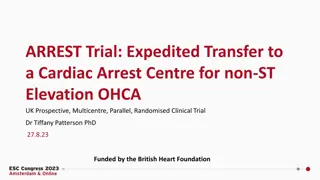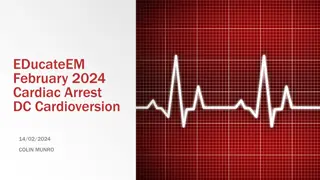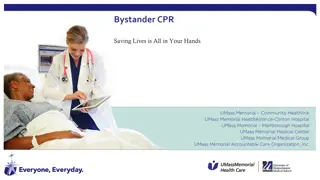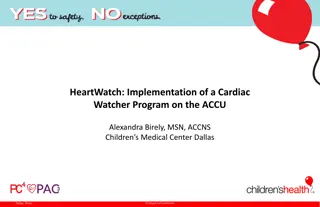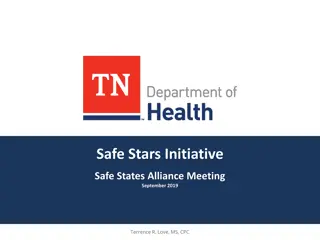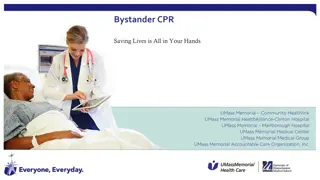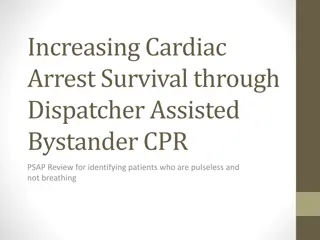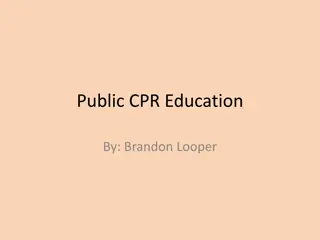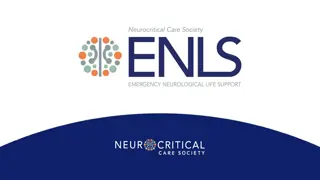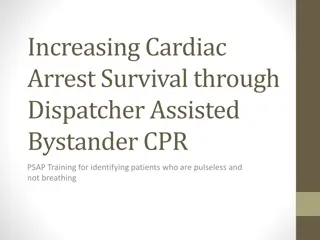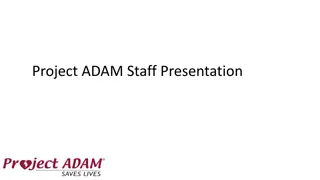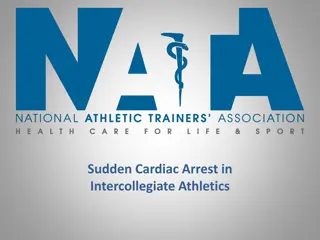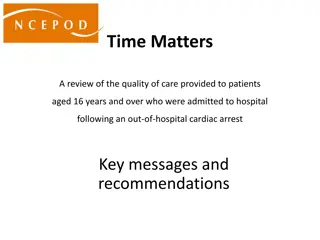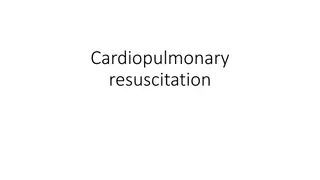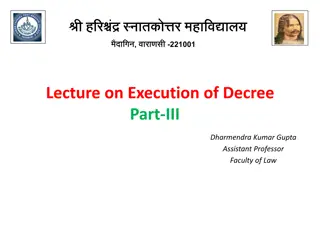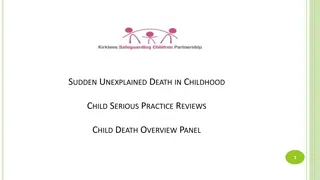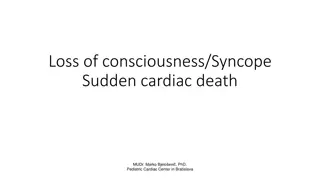Understanding Sudden Cardiac Arrest and Prevention Measures
Sudden Cardiac Arrest (SCA) is a life-threatening event that occurs without warning due to electrical malfunctions in the heart. The condition can lead to loss of consciousness and death within minutes if not treated promptly. This training program covers CPR/AED techniques, key components of CPR, and information on the causes of SCA, including both inherited and acquired conditions. By raising awareness and emphasizing preventive measures, such as proper training and quick response protocols, the program aims to equip individuals with the knowledge and skills to potentially save lives.
Download Presentation

Please find below an Image/Link to download the presentation.
The content on the website is provided AS IS for your information and personal use only. It may not be sold, licensed, or shared on other websites without obtaining consent from the author. Download presentation by click this link. If you encounter any issues during the download, it is possible that the publisher has removed the file from their server.
E N D
Presentation Transcript
Extracurricular Activity Safety Training Program
Section 1 CPR/AED Sudden Cardiac Arrest
Key CPR Components Compression Rate at least 100/min (to the beat of Bee Gees song Stayin Alive) Minimize interruptions in Compressions (< 10 sec) If AED present Compressions must be performed before and after a shock
Sudden Cardiac Awareness Information What is Sudden Cardiac Arrest? Occurs suddenly and often without warning. An electrical malfunction (short-circuit) causes the bottom chambers of the heart (ventricles) to beat dangerously fast (ventricular tachycardia or fibrillation) and disrupts the pumping ability of the heart. The heart cannot pump blood to the brain, lungs and other organs of the body. The person loses consciousness (passes out) and has no pulse. Death occurs within minutes if not treated immediately.
Sudden Cardiac Awareness Information What causes Sudden Cardiac Arrest? Conditions present at birth Inherited (passed on from parents/relatives) conditions of the heart muscle: Hypertrophic Cardiomyopathy hypertrophy (thickening) of the left ventricle; the most common cause of sudden cardiac arrest in athletes in the U.S. Arrhythmogenic Right Ventricular Cardiomyopathy replacement of part of the right ventricle by fat and scar; the most common cause of sudden cardiac arrest in Italy. Marfan Syndrome a disorder of the structure of blood vessels that makes them prone to rupture; often associated with very long arms and unusually flexible joints. Inherited conditions of the electrical system: Lonq QT Syndrome abnormality in the ion channels (electrical system) of the heart. Catecholaminergic Polymorphic Ventricular Tachycardia and Brugada Syndrome other types of electrical abnormalities that are rare but run in families. NonInherited (not passed on from the family, but still present at birth) conditions: Coronary Artery Abnormalities abnormality of the blood vessels that supply blood to the heart muscle. The second most common cause of sudden cardiac arrest in athletes in the U.S. Aortic valve abnormalities failure of the aortic valve (the valve between the heart and the aorta) to develop properly; usually causes a loud heart murmur. Non-compaction Cardiomyopathy a condition where the heart muscle does not develop normally. Wolff-Parkinson-White Syndrome an extra conducting fiber is present in the heart s electrical system and can increase the risk of arrhythmias.
Sudden Cardiac Awareness Information What causes Sudden Cardiac Arrest continued Conditions not present at birthbut acquired later in life: Commotio Cordis concussion of the heart that can occur from being hit in the chest by a ball, puck, or fist. Myocarditis infection/inflammation of the heart, usually caused by a virus. Recreational/Performance-Enhancing drug use. Idiopathic: Sometimes the underlying cause of the Sudden Cardiac Arrest is unknown, even after autopsy. What are the symptoms/warning signs of Sudden Cardiac Arrest? Fainting/blackouts (especially during exercise) Dizziness Unusual fatigue/weakness Chest pain Shortness of breath Nausea/vomiting Palpitations (heart is beating unusually fast or skipping beats) Family history of sudden cardiac arrest at age < 50 **ANY of these symptoms/warning signs that occur while exercising may necessitate further evaluation from your physician before returning to practice or a game.
Sudden Cardiac Awareness Information What is the treatment for Sudden Cardiac Arrest? Time is critical and an immediate response is vital. CALL 911 Begin CPR Use an Automated External Defibrillator (AED) What are ways to screen for Sudden Cardiac Arrest? The American Heart Association recommends a pre-participation history and physical including 14 important cardiac elements. The UIL Pre-Participation Physical Evaluation Medical History form includes ALL 14 of these important cardiac elements and is mandatory annually. Additional screening using an electrocardiogram and/or an echocardiogram is readily available to all athletes, but is not mandatory.
Section 2 Head and Neck Injuries Concussions
Reducing Head and Neck Injuries Complete preseason physical exams and medical histories for all participants in accordance with established rules. Coaches and officials should discourage the players from using their heads as battering rams. The rules prohibiting spearing and helmet-to-helmet contact should be enforced in practice and in games. The players should be taught to respect the helmet as a protective device and that the helmet should not be used as a weapon. Coaches should drill the athletes in the proper execution of the fundamentals of football skills, particularly blocking and tackling. Keep the head out of football. All coaches, physicians, and athletic trainers should take special care to see that each player's equipment is properly fitted, particularly the helmet. When a player has experienced or shown signs of head trauma they should receive immediate medical attention and should not be allowed to return to practice or game until they complete the District Concussion Protocol requirements.
Definition of Concussion There are numerous definitions of concussion available in medical literature as well as in the previously noted guidelines developed by the various state organizations. The feature universally expressed across definitions is that concussion 1) is the result of a physical, traumatic force to the head and 2) that force is sufficient to produce altered brain function which may last for a variable duration of time. For the purpose of this program the definition presented in Chapter 38, Sub Chapter D of the Texas Education Code is considered appropriate: "Concussion" means a complex pathophysiological process affecting the brain caused by a traumatic physical force or impact to the head or body, which may: (A) include temporary or prolonged altered brain function resulting in physical, cognitive, or emotional symptoms or altered sleep patterns; and (B) involve loss of consciousness.
Concussion Symptoms/Signs Symptoms reported by athletes may include: headache; nausea; balance problems or dizziness; double or fuzzy vision; sensitivity to light or noise; feeling sluggish; feeling foggy or groggy; concentration or memory problems; confusion. Signs observed by parents, friends, teachers or coaches may include: appears dazed or stunned; is confused about what to do; forgets plays; is unsure of game, score or opponent; moves clumsily; answers questions slowly; loses consciousness; shows behavior or personality changes; can t recall events prior to hit; can t recall events after hit. Any one or group of symptoms may appear immediately and be temporary, or delayed and long lasting. The appearance of any one of these symptoms should alert the responsible personnel to the possibility of concussion. IF YOU EXPERIENCE ANY OF THESE SIGNS OR SYMPTOMS AFTER HEAD TRAUMA OR WITNESS THEM IN ANOTHER ATHLETE TELL A COACH OR ATHLETIC TRAINER IMMEDIATELY!
Concussion Management Protocol Fort Worth ISD has established a Concussion Oversight Team (COT) in accordance with Section 38.153 of the Texas Education Code (TEC) that includes all Athletic Trainers employed by the district at its High Schools and Dr. Michelle Kirk, who works for JPS Hospital system. The COT has established a Concussion Management Protocol that clearly defines the steps to be followed by students, parents and school medical personnel responsible for supervising the treatment of a concussion. In Fort Worth ISD this is the High School Athletic Trainer. This Protocol includes treatment of a suspected concussion, a Return-to-Play protocol and academic accommodations. The High School Athletic Trainer is the sole responsible party for determining when a student has complied with all aspects of the Concussion Management Protocol. All communication between parents, student, treating physicians, coaches and necessary school personnel should include the High School Athletic Trainer. The Athletic Trainer will use the SCAT3 (Sport Concussion Assessment Tool 3) as the primary evaluation tool to assess a suspected concussion. The SCAT3 will be performed at the time of the suspected concussion, if possible, then again before the student returns to school. A final SCAT3 will be performed when the symptoms have resolved and permission from the treating physician is being sought to begin the Return-to-Play protocol. An online cognitive baseline is required for all students participating in High School Athletics prior to participation. Also, a UIL Concussion Acknowledgement form must be signed and turned in prior to participation.
Response to Suspected Concussion According to section 38.156 of the Texas Education Code (TEC), a student shall be removed from an interscholastic athletics practice or competition immediately if one of the following persons believes the student might have sustained a concussion during the practice or competition: (1) a coach; (2) a physician; (3) a licensed health care professional; or (4) the student's parent or guardian or another person with legal authority to make medical decisions for the student. If a student-athlete demonstrates signs or symptoms consistent with concussion, follow the Heads Up 4-Step Action Plan: The student-athlete shall be immediately removed from game/practice as noted above. Have the student-athlete evaluated by an appropriate health care professional as soon as practicable. Inform the student-athletes parent or guardian about the possible concussion and give them information on concussion. If it is determined that a concussion has occurred, the student-athlete shall not be allowed to return to participation that day regardless of how quickly the signs or symptoms of the concussion resolve and shall be kept from activity until a physician indicates they are symptom free and gives clearance to begin the Return to Play Protocol. A coach of a team may not authorize a student s return to play.
Response to Suspected Concussion Cont. Concussion suspected - SCAT3 performed if possible Student sent home with parent/guardian Student sent to E.R. via parent/guardian or ambulance Rest at home at least 24 hours Student and, if possible, parent/guardian meet with Athletic Trainer before returning to school - SCAT3 performed
While at home resting. GO TO THE HOSPITAL IMMEDIATELY IF ANY OF THESE SIGNS ARE VISIBLE: - Worsening headache - Very Drowsy - Can t recognize people and/or places - Repeated Vomiting - Have weak or numb arms or legs - Confused or Very Irritable - Seizures - Unsteady - Slurred Speech - Unable to stay awake It is very important to REST THE BRAIN! So do the following to provide the brain enough time to recover: - Sleep as much as you need to you need a darkened, quiet environment - TAKE AWAY ACCESS TO ALL ELECTRONIC DEVICES. Phones, ipod, computer, television, game systems make the eyes strain and the brain work not rest. - Watch for the above signs and, if observed, take to ER or call 911 immediately. - Continue total rest for at least 24 hours. This may mean they miss school or practice which is fine. They need rest and sensory deprivation more than anything. - Don t use alcohol, drive, use sleeping tablets or do any strenuous activity. - Return to the High School Athletic Trainer after at least 24 hours so they can begin evaluating the severity of the concussion. - If you feel the need for pain medication, only use Acetaminophen (Tylenol).
When you return to school.. After the student has rested for at least 24 hours and has met, preferably along with their parent/guardian, with the Athletic Trainer then they can return to school. - Temporary Academic Accommodations may be used to allow the student to stay in school without worsening the symptoms of the concussion. The student must meet with the Athletic Trainer every 24-48 hours to complete a Daily Signs and Symptoms Worksheet to monitor the severity of the concussion. When the student exhibits no further signs or symptoms (self reported as all zeroes on the Daily Signs and Symptoms Worksheet) then they will complete an online cognitive assessment to compare with their pre-season baseline. If significant progress has been made then the student is ready to be cleared by their treating physician to begin the Return-to-Play protocol. - A Concussion Release Form needs to be completed by the treating physician and returned to the Athletic Trainer.
Return-to-Play Protocol Once the student has been cleared by a physician (and the Concussion Release Form has been turned in to the Athletic Trainer) then the student is ready to begin the Return-to-Play Protocol. - The Athletic Trainer will supervise each step of the Return-to-Play Protocol and document completion in the students medical records. - One step of the Return-to-Play Protocol may be completed every 24 hours as long as the student does not begin to experience any concussion symptoms. -If the student begins to have concussion symptoms during the Return-to-Play Protocol then they must rest for at least 24 hours and report all zeroes on the Daily Signs and Symptoms Worksheet before restarting the Return-to-Play protocol. The steps in the Return-to-Play Protocol are: Step 1 - stationary bike for 30 minutes or walking outside for 1 mile Step 2 light running no more than 2 miles and non-impact activities Step 3 running of no more than 4 miles and non-impact, sport-specific activities (if applicable, wear sport-specific equipment such as helmet, shoulder pads, etc.) Step 4 may participate in full contact practice After completing all steps with no symptoms, you must get a final clearance from treating physician (may have been given prior contingent on successfully completing the Return-to-Play Protocol) and complete the UIL Concussion Return to Play form.
Potential Need for School/Academic Adjustments & Modification Following Concussion (Return to Learn) It may be necessary for individuals with concussion to have both cognitive and physical rest in order to achieve maximum recovery in shortest period of time. In addition to the physical management noted above, it is recommended that the following be considered: Notify school nurse and all classroom teachers regarding the student-athlete s condition. Advise teachers of post concussion symptoms. Student may need (only until asymptomatic) special accommodations regarding academic requirements (such as limited computer work, reading activities, testing, assistance to class, etc.) until concussion symptoms resolve. Student may only be able to attend school for half days or may need daily rest periods until symptoms subside. In special circumstances the student may require homebound status for a brief period.
Section 3 Heat, Hydration and Asthma
Heat Illness Heat Cramps - Painful cramps involving abdominal muscles and extremities caused by intense, prolonged exercise in the heat and depletion of salt and water due to sweating. Heat Syncope - Weakness, fatigue and fainting due to loss of salt and water in sweat and exercise in the heat. Predisposes to heatstroke. Heat Exhaustion (Water Depletion) - Excessive weight loss, reduced sweating, elevated skin and core body temperature, excessive thirst, weakness, headache and sometimes unconciousness. Heat Exhaustion (Salt Depletion) - Exhaustion, nausea, vomiting, muscle cramps, and dizziness due to profuse sweating and inadquate replacement of body salts. Heatstroke - An acute medical emergency related to thermoregulatory failure. Associated with nausea, seizures, disorientation, and possible unconciousness or coma. It may occur suddenly without being preceded by any other clinical signs. The individual is usually unconscious with a high body temperature and a hot dry skin (heatstroke victims, contrary to popular belief, may sweat profusely).
Hydration Tips And Fluid Guidelines Many athletes do not voluntarily drink enough water to prevent significant dehydration during physical activity. Drink regularly throughout all physical activities. An athlete cannot always rely on his or her sense of thirst to sufficiently maintain proper hydration. Drink before, during, and after practices and games. For example: Drink 16 ounces of fluid 2 hours before physical activity. Drink another 8 to 16 ounces 15 minutes before physical activity. During physical activity, drink 4 to 8 ounces of fluid every 15 to 20 minutes (some athletes who sweat considerably can safely tolerate up to 48 ounces per hour). After physical activity, drink 16 to 20 ounces of fluid for every pound lost during physical activity to achieve normal hydration status before the next practice or competition.
Recommendations for Hydration WHAT NOT TO DRINK Fruit juices with greater than 8 percent carbohydrate content and carbonated soda can both result in a bloated feeling and abdominal cramping. Athletes should be aware that nutritional supplements are not limited to pills and powders as many of the new energy drinks contain stimulants such as caffeine and/or ephedrine. These stimulants may increase the risk of heat illness and/or heart problems with exercise. They can also cause anxiety, jitteriness, nausea, and upset stomach or diarrhea. Many of these drinks are being produced by traditional water, soft drink and sports drink companies which can cause confusion in the sports community. As is true with other forms of supplements, these "power drinks , energy drinks , or fluid supplements" are not regulated by the FDA. Thus, the purity and accuracy of contents on the label is not guaranteed. Many of these beverages which claim to increase power, energy, and endurance, among other claims, may have additional ingredients that are not listed. Such ingredients may be harmful and may be banned by governing bodies like the NCAA, USOC, or individual state athletic associations.
Recommendations for Hydration WHAT TO DRINK DURING EXERCISE For most exercising athletes, water is appropriate and sufficient for pre-hydration and rehydration. Water is quickly absorbed, well-tolerated, an excellent thirst quencher and cost-effective. Traditional sports drinks with an appropriate carbohydrate and sodium formulation may provide additional benefit in the following general situations: Prolonged continuous or intermittent activity of greater than 45 minutes Intense, continuous or repeated exertion Warm-to-hot and humid conditions Traditional sports drinks with an appropriate carbohydrate and sodium formulation may provide additional benefit for the following individual conditions: Poor hydration prior to participation A high sweat rate or salty sweater Poor caloric intake prior to participation Poor acclimatization to heat and humidity A 6 to 8% carbohydrate formulation is the maximum that should be utilized in a sports drink. Any greater concentration will slow stomach emptying and potentially cause the athlete to feel bloated. An appropriate sodium concentration (0.4 1.2 grams per liter) will help with fluid retention and distribution and decrease the risk of exertional muscle cramping.
Asthma and Exercise Be aware of the major signs and symptoms of asthma, such as coughing, wheezing tightness in the chest, shortness of breath and breathing difficulty at night, upon awakening in the morning or when exposed to certain allergens or irritants. If you have asthma: Devise an asthma action plan with your doctor for managing your asthma and provide a copy to your school nurse and athletic trainer If you carry a rescue inhaler, you must have a Self Administration of Prescribed Asthma or Anaphylaxis Medicine by Student completed and turned in to the school nurse and athletic trainer. If you have a prescribed rescue inhaler, you must have it available with you at all practices and competitions or you may not participate. Be aware of Ozone Action Days . You may not be allowed to participate or may be allowed to go inside if your symptoms worsen. You should have follow-up examinations at regular intervals with their primary care physician or specialist. These evaluations should be scheduled at least every six to 12 months. Athletes with atypical symptoms; symptoms that occur despite proper therapy; or other complications that can exacerbate asthma (e.g. sinusitis, nasal polyps, severe rhinitis, gastroesophageal reflux disease [GERD] or vocal cord dysfunction), should be evaluated by a physician with expertise in asthma. They include allergists, ear, nose and throat physicians, cardiologists and pulmonologists trained in providing care for athletes.
Section 4 Anabolic Steroids and Nutritional Supplements
Illegal Steroid Use and Random Anabolic Steroid Testing Texas state law prohibits possessing, dispensing, delivering or administering a steroid in a manner not allowed by state law. Texas state law also provides that bodybuilding, muscle enhancement or the increase in muscle bulk or strength through the use of a steroid by a person who is in good health is not a valid medical purpose. Texas state law requires that only a medical doctor may prescribe a steroid for a person. Any violation of state law concerning steroids is a criminal offense punishable by confinement in jail or imprisonment in the Texas Department of Criminal Justice. As a prerequisite to participation in UIL athletic activities, student-athletes must agree that they will not use anabolic steroids as defined in the UIL Anabolic Steroid Testing Program Protocol and that they understand that they may be asked to submit to testing for the presence of anabolic steroids in their body. Additionally, as a prerequisite to participation in UIL athletic activities, student-athletes must agree to submit to such testing and analysis by a certified laboratory if selected.
Illegal Steroid Use and Random Anabolic Steroid Testing, Cont. Also, as a prerequisite to participation by a student in UIL athletic activities, their parent or guardian must certify that they understand that their student must refrain from anabolic steroid use and that the student may be asked to submit to testing for the presence of anabolic steroids in his/her body. The parent or guardian also must agree to submit their child to such testing and analysis by a certified laboratory if selected. The results of the steroid testing will only be provided to certain individuals in the student s high school as specified in the UIL Anabolic Steroid Testing Program Protocol which is available on the UIL website at www.uiltexas.org. Additionally, results of steroid testing will be held confidential to the extent required by law.
Health Consequences Associated with Anabolic Steroid Abuse Boys and Men - reduced sperm production, shrinking of the testicles, impotence, difficulty or pain in urinating, baldness, and irreversible breast enlargement (gynecomastia). Girls and Women - development of more masculine characteristics, such as decreased body fat and breast size, deepening of the voice, excessive growth of body hair, and loss of scalp hair. Adolescents of both sexes - premature termination of the adolescent growth spurt, so that for the rest of their lives, abusers remain shorter than they would have been without the drugs. Males and females of all ages - potentially fatal liver cysts and liver cancer; blood clotting, cholesterol changes, and hypertension, each of which can promote heart attack and stroke; and acne. Although not all scientists agree, some interpret available evidence to show that anabolic steroid abuse-particularly in high doses-promotes aggression that can manifest itself as fighting, physical and sexual abuse, armed robbery, and property crimes such as burglary and vandalism. Upon stopping anabolic steroids, some abusers experience symptoms of depressed mood, fatigue, restlessness, loss of appetite, insomnia, reduced sex drive, headache, muscle and joint pain, and the desire to take more anabolic steroids. In injectors, infections resulting from the use of shared needles or non-sterile equipment, including HIV/AIDS, hepatitis B and C, and infective endocarditis, a potentially fatal inflammation of the inner lining of the heart. Bacterial infections can develop at the injection site, causing paid and abscess.
Nutritional / Dietary Supplements The contents and purity of nutritional / dietary supplements are NOT tested closely or regulated by the Food and Drug Administration (FDA). As such, UIL is making student athletes and parents aware of the possibility of supplement contamination and the potential effect on a student athletes steroid test. UIL does not approve or disapprove supplements. Contaminated supplements could lead to a positive steroid test. The use of supplements is at the student-athlete s own risk. Student-athletes and interested individuals with questions or concerns about these substances should consult their physician for further information. Student athletes must be aware that they are responsible for everything they eat, drink and put into their body. Ignorance and/or lack of intent are not acceptable excuses for a positive steroid test result. The American College of Cardiology recommends that "Athletes should have their nutritional needs met through a healthy balanced diet without dietary supplements". Appropriate advice on athlete nutrition can be found at the school s Athletics webpage.
Section 5 Lightning Safety
Recommendations for Lightning Safety When thunder is heard within 30 seconds of a visible lightning strike, or a cloud-to-ground lightning bolt is seen, the thunderstorm is close enough to strike your location with lightning. Suspend play for thirty minutes and take shelter immediately. Once activities have been suspended, wait at least thirty minutes following the last sound of thunder or lightning flash prior to resuming an activity or returning outdoors. When you are told to leave the field and move to a designated safe area, please do so quickly. That is not the time to pick up equipment or play around. Avoid being the highest point in an open field, in contact with, or proximity to the highest point, as well as being on the open water. Do not take shelter under or near trees, flagpoles, or light poles. Assume that lightning safe position (crouched on the ground weight on the balls of the feet, feet together, head lowered, and ears covered) for individuals who feel their hair stand on end, skin tingle, or hear "crackling" noises. Do not lie flat on the ground. All individuals have the right to leave an athletic site in order to seek a safe structure if the person feels in danger of impending lightning activity, without fear of repercussions or penalty from anyone.
Recommendations for Lightning Safety, Cont. Safe Shelter: A safe location is any substantial, frequently inhabited building. The building should have four solid walls (not a dug out), electrical and telephone wiring, as well as plumbing, all of which aid in grounding a structure. The secondary choice for a safer location from the lightning hazard is a fully enclosed vehicle with a metal roof and the windows completely closed. It is important to not touch any part of the metal framework of the vehicle while inside it during ongoing thunderstorms. It is not safe to shower, bathe, or talk on landline phones while inside of a safe shelter during thunderstorms (cell phones are ok). Postpone or suspend activity if a thunderstorm appears imminent before or during an activity or contest (irrespective of whether lightning is seen or thunder heard) until the hazard has passed. Signs of imminent thunderstorm activity are darkening clouds, high winds, and thunder or lightning activity.
Section 6 Communicable Diseases
Communicable Disease Procedures The risk for blood-borne infectious diseases, such as HIV/Hepatitis B, remains low in sports and to date has not been reported. Proper precautions are needed to minimize the potential risk of spreading these diseases. In addition to these diseases that can be spread through transmission of bodily fluids only, skin infections that occur due to skin contact with competitors and equipment deserve close oversight, especially considering the emergence of the potentially more serious infection with Methicillin- Resistant Staphylococcus Aureus (MRSA).
Communicable Disease Procedures, Cont. Universal Hygiene Protocol for All Sports Shower immediately after all competition and practice Wash all workout clothing after practice Wash personal gear (knee pads and braces) weekly. Do not share towels or personal hygiene products (razors) with others. Refrain from full body (chest, arms, abdomen) cosmetic shaving.
Communicable Disease Procedures, Cont. Means of reducing the potential exposure to Infectious Skin Diseases include- Athletes must be told to notify a parent or guardian, athletic trainer and coach of any skin lesion prior to any competition or practice. An appropriate health-care professional should evaluate any skin lesion before returning to competition. If an outbreak occurs on a team, especially in a contact sport, all team members should be evaluated to help prevent the potential spread of the infection. Coaches, officials, and appropriate health-care professionals must follow NFHS or state/local guidelines on time until return to competition. Participation with a covered lesion may be considered if in accordance with NFHS, state or local guidelines and the lesion is no longer contagious.
Communicable Disease Procedures, Cont. Means of reducing the potential exposure to Blood-Borne Infectious Diseases include: * An athlete who is bleeding, has an open wound, has any amount of blood on his/her uniform or has blood on his/her person, shall be directed to leave the activity until the bleeding is stopped, the wound is covered, the uniform and/or body is appropriately cleaned and/or the uniform is changed before returning to activity. * Certified athletic trainers or caregivers need to wear gloves and take other precautions to prevent blood-splash from contaminating themselves or others. * Immediately wash contaminated skin or mucous membranes with soap and water. * Clean all contaminated surfaces and equipment with disinfectant before returning to competition. Be sure to use gloves with cleaning. * Any blood exposure or bites to the skin that break the surface must be reported and evaluated by a medical provider immediately.
Sources American College of Cardiology California Interscholastic Federation National Athletic Trainers Association National Federation of State High School Associations National Institute on Drug Abuse Syracuse University Texas Education Agency University Interscholastic League Google Images


